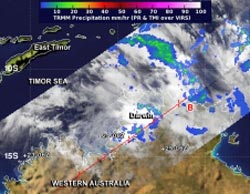NASA Sees Tropical Cyclone Alessia Make Landfall Near Darwin

NASA's TRMM satellite passed over Tropical Storm Alessia on November 24 at 1325 UTC/8:25 a.m. EST and identified mostly light rain from the system (blue) with a small area (green) of moderate rainfall. <br>Image Credit: NASA/SSAI, Hal Pierce<br>
The final warning on the tropical storm was issued on November 24 from the Joint Typhoon Warning Center at 0900 UTC/4 a.m. EST. At that time, Tropical Cyclone Alessia was located near 13.8 south latitude and 129.0 east longitude, about 136 nautical miles/156.5 miles/252 km southwest of Darwin, Australia. Alessia was moving to the east at 15 knots/17.2 mph/27.7 kph and had maximum sustained winds near 35 knots/40 mph/62 kph at the time.
NASA's Tropical Rainfall Measuring Mission or TRMM satellite passed over Tropical Storm Alessia on November 24 at 1325 UTC/8:25 a.m. EST and identified mostly light rain from the system with a small area of moderate rainfall, falling at a rate of 1.18 inch/30 mm per hour.
Cyclone Alessia crossed Australia's Northern Territory coast and made landfall south of Darwin during the night-time hours and quickly dissipated.
The Australian Bureau of Meteorology reported that the Upper Adelaide River, just north of where Alessia made landfall, received tropical-storm-force winds and received about 54 millimeters of rain. No damages were reported.
Text credit: Rob Gutro
NASA's Goddard Space Flight Center
Media Contact
All latest news from the category: Earth Sciences
Earth Sciences (also referred to as Geosciences), which deals with basic issues surrounding our planet, plays a vital role in the area of energy and raw materials supply.
Earth Sciences comprises subjects such as geology, geography, geological informatics, paleontology, mineralogy, petrography, crystallography, geophysics, geodesy, glaciology, cartography, photogrammetry, meteorology and seismology, early-warning systems, earthquake research and polar research.
Newest articles

Properties of new materials for microchips
… can now be measured well. Reseachers of Delft University of Technology demonstrated measuring performance properties of ultrathin silicon membranes. Making ever smaller and more powerful chips requires new ultrathin…

Floating solar’s potential
… to support sustainable development by addressing climate, water, and energy goals holistically. A new study published this week in Nature Energy raises the potential for floating solar photovoltaics (FPV)…

Skyrmions move at record speeds
… a step towards the computing of the future. An international research team led by scientists from the CNRS1 has discovered that the magnetic nanobubbles2 known as skyrmions can be…




















